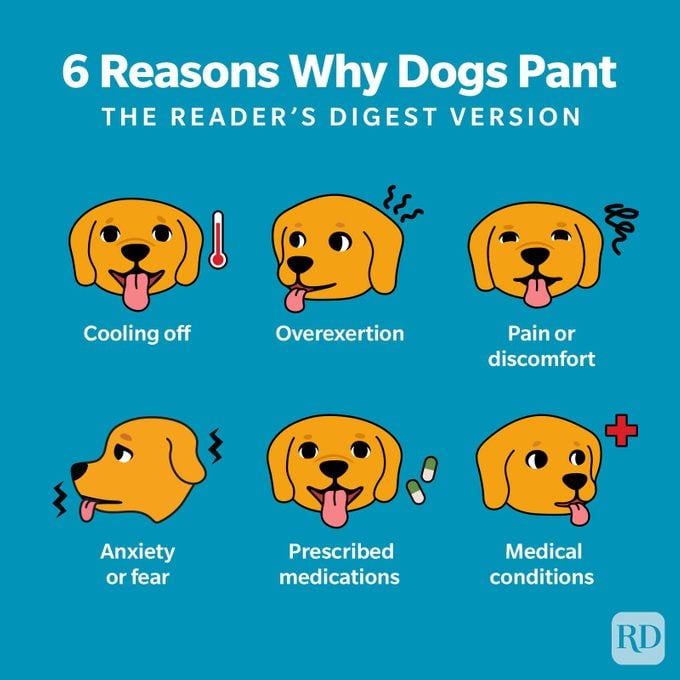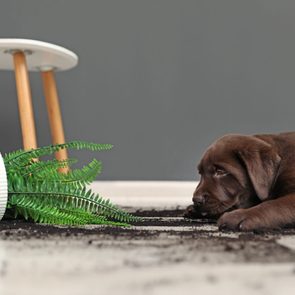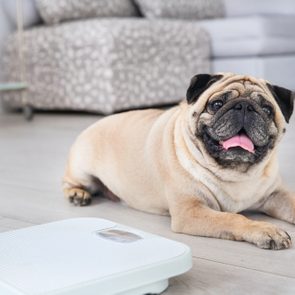Why Do Dogs Pant? 6 Common Reasons, According to Experts
Updated: Mar. 21, 2024

Panting is a perfectly natural behavior, until it's not. So why do dogs pant? Experts share the most common reasons and how to recognize when something is off.
If you have a dog, panting is a daily occurrence. Chances are you’ve noticed your dog panting while playing fetch or on a warm day. Sometimes, your dog gets so excited about the cheeseburger you’re eating, it pants in anticipation, hoping you’ll toss a piece its way. “Every dog pants, and most of the time, it’s completely normal dog behavior and nothing to worry about,” says Lindsay Butzer, DVM, a veterinarian and PetMeds partner. We know it’s common behavior, similar to why dogs shake and why dogs sigh, but why do dogs pant? Is it a signal that they’re happy or a sign your dog is in pain? Could panting pups be suffering from dog anxiety? We tapped the experts to learn all the reasons why.

What is panting?
If you were playing charades and had to act out “dog panting,” it would be a breeze. Even people who don’t have dogs recognize the open mouth, tongue hanging out, audible breathing signs of panting. It’s just about as normal as dog zoomies or dogs eating grass. But there’s a little more to it than that. “We say that a dog is panting when they are moving air rapidly in and out, but the chest is not moving significantly,” says Laura Greene, DVM, veterinarian at Merck Animal Health.
Still, panting does seem very labor-intensive at times, and you might be wondering what the difference is between panting and troubled breathing, especially if you have an adorable short-nose, flat-faced dog breed, like a bulldog or pug, whose sweet snouts aren’t as efficient at getting air in and out.
“Dogs with difficulty breathing can be breathing quickly or slowly, depending on the underlying cause, but typically have more chest and/or belly movement than what is seen with panting,” Dr. Greene says. This could be your dog asking for help and warrants a call to your vet. Troubled breathing, also known as dyspnea, means that the body is not getting enough oxygen. It could stem from a variety of causes, such as infectious respiratory disease, airway obstruction, heart failure, anemia and other conditions.
Why do dogs pant?
Most of the time though, panting isn’t a big deal. It’s normal to see dogs panting when they get too hot on a warm day. Some dogs love squeaky toys so much that they pant with excitement or while playing fetch. But perhaps the most adorable example of why dogs pant is when they are content. Their mouth is soft, relaxed and open, with barely noticeable panting. Pair that with bright eyes, and you have the quintessential doggie smile. Here are some other reasons for dog panting.
To cool off
Cooling off is one of the most common answers to the question “Why do dogs pant?” Panting might seem like a counterintuitive way to remove excess heat (it looks so laborious), but it works. “As moisture from the mouth and tongue evaporates through panting, heat is released, which cools the blood vessels in the mouth and on the tongue,” Dr. Butzer says. “This cooler blood gets pumped throughout the body and lowers overall body temperature.” If panting becomes excessive and your dog has a wide-open mouth or seems to be working harder to breathe, it’s a clear sign of heat stroke. Call your veterinarian and start cooling down your dog by soaking them in cool or lukewarm water in a tub or using towels—never use ice-cold water, which could slow blood flow and hinder the cooling process.
Overexertion
Fun fact about dogs: Most delight in a good game of fetch. But you know that out-of-breath feeling you get after climbing several flights of stairs? Dogs get tuckered out too when they expend a lot of energy, like when they’re running back and forth to grab the ball. While it’s normal for heavy panting to occur in this scenario, it’s important to look for cues that it’s time to slow things down. Your dog may take longer to return the ball or just plop down on the ground. That’s a sign your pup needs a break—and a drink of water.
Pain
Dogs can’t talk, but they sure say a lot through their body language and behavior. For instance, a dog’s tail can reveal emotions like happiness and fear. A dog stares at you often for reassurance and understanding. And a dog’s facial expressions, such as eyebrow raising or squinting, can tell you a lot, including when it’s in pain. When panting is due to pain, whether it be from nausea, a hurt knee, surgery recovery or other conditions, you might notice that your dog can’t get comfortable, is restless, has a loss of appetite or is licking the pain site. “In some cases, panting is one of the earlier signs a pet owner will notice indicating progressive arthritis and joint or bone pain,” says Dr. Greene.
Anxiety
Whether it’s fireworks, a trip to the vet or a new furry addition to your family, anxiety can cause panting and other symptoms, such as drooling, pacing and hiding. Want to calm an anxious dog? It’s possible with behavioral training, but it might not work for every pup. In that case, these dog anxiety products might do the trick.
Medications
Certain medicines can cause excessive panting. Prednisolone and other corticosteroids are commonly prescribed to treat allergies, inflammation and gastrointestinal diseases. Painkillers for dogs and sedative drugs may cause increased panting, and you should let your vet know if you notice these symptoms while your dog is on medication.
Medical problems
Some medical conditions may cause rapid or heavy panting (in addition to other accompanying symptoms). Heart failure, Cushing’s disease (when the adrenal glands overproduce cortisol), laryngeal paralysis, respiratory illness and obesity are some examples. Food poisoning or munching on a poisonous plant discovered in the backyard might also prompt panting.
When should I worry about dog panting?
“Panting is typically only an emergency if it occurs secondary to heat stroke [or as a result of medical problems or ingesting something toxic],” says Dr. Greene. When you’re worried and scared, it might be hard to tell the difference between excessive panting and difficulty breathing. Dr. Greene says you can try to distract your dog with food or a treat. “Generally, panting dogs will be amenable to distraction (if only briefly), whereas dogs who are in respiratory distress are often too focused on the effort of breathing to be interested in a treat.”
Take note of your dog’s gums. Panting dogs typically have bright-pink-colored gums. Dogs in respiratory distress have very pale, brown, muddy or blue-tinged gums. Their head and neck are extended, and there is increased abdominal effort to breathe. Dogs in respiratory distress require immediate veterinary attention.
If you’ve noticed your dog is panting a bit more than usual but not alarmingly excessive, make an appointment with your vet. In the meantime, Dr. Butzer suggests noting when they’re panting and how they’re acting when they pant so you can share the info with your vet to help them determine an underlying cause.
Sources:
- Lindsay Butzer, DVM, veterinarian and PetMeds partner
- Laura Greene, DVM, DACVIM, veterinarian and internal medicine specialist at Merck Animal Health
- Merck Veterinary Manual: “Corticosteroids in Animals”























